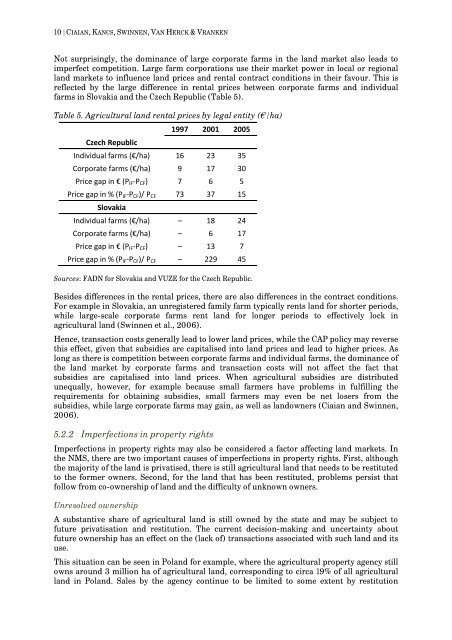Institutional Factors Affecting Agricultural Land Markets
Institutional Factors Affecting Agricultural Land Markets
Institutional Factors Affecting Agricultural Land Markets
Create successful ePaper yourself
Turn your PDF publications into a flip-book with our unique Google optimized e-Paper software.
10 | CIAIAN, KANCS, SWINNEN, VAN HERCK & VRANKEN<br />
Not surprisingly, the dominance of large corporate farms in the land market also leads to<br />
imperfect competition. Large farm corporations use their market power in local or regional<br />
land markets to influence land prices and rental contract conditions in their favour. This is<br />
reflected by the large difference in rental prices between corporate farms and individual<br />
farms in Slovakia and the Czech Republic (Table 5).<br />
Table 5. <strong>Agricultural</strong> land rental prices by legal entity (€/ha)<br />
Czech Republic<br />
1997 2001 2005<br />
Individual farms (€/ha) 16 23 35<br />
Corporate farms (€/ha) 9 17 30<br />
Price gap in € (P IF ‐P CF ) 7 6 5<br />
Price gap in % (P IF ‐P CF )/ P CF 73 37 15<br />
Slovakia<br />
Individual farms (€/ha) – 18 24<br />
Corporate farms (€/ha) – 6 17<br />
Price gap in € (P IF ‐P CF ) – 13 7<br />
Price gap in % (P IF ‐P CF )/ P CF – 229 45<br />
Sources: FADN for Slovakia and VUZE for the Czech Republic.<br />
Besides differences in the rental prices, there are also differences in the contract conditions.<br />
For example in Slovakia, an unregistered family farm typically rents land for shorter periods,<br />
while large-scale corporate farms rent land for longer periods to effectively lock in<br />
agricultural land (Swinnen et al., 2006).<br />
Hence, transaction costs generally lead to lower land prices, while the CAP policy may reverse<br />
this effect, given that subsidies are capitalised into land prices and lead to higher prices. As<br />
long as there is competition between corporate farms and individual farms, the dominance of<br />
the land market by corporate farms and transaction costs will not affect the fact that<br />
subsidies are capitalised into land prices. When agricultural subsidies are distributed<br />
unequally, however, for example because small farmers have problems in fulfilling the<br />
requirements for obtaining subsidies, small farmers may even be net losers from the<br />
subsidies, while large corporate farms may gain, as well as landowners (Ciaian and Swinnen,<br />
2006).<br />
5.2.2 Imperfections in property rights<br />
Imperfections in property rights may also be considered a factor affecting land markets. In<br />
the NMS, there are two important causes of imperfections in property rights. First, although<br />
the majority of the land is privatised, there is still agricultural land that needs to be restituted<br />
to the former owners. Second, for the land that has been restituted, problems persist that<br />
follow from co-ownership of land and the difficulty of unknown owners.<br />
Unresolved ownership<br />
A substantive share of agricultural land is still owned by the state and may be subject to<br />
future privatisation and restitution. The current decision-making and uncertainty about<br />
future ownership has an effect on the (lack of) transactions associated with such land and its<br />
use.<br />
This situation can be seen in Poland for example, where the agricultural property agency still<br />
owns around 3 million ha of agricultural land, corresponding to circa 19% of all agricultural<br />
land in Poland. Sales by the agency continue to be limited to some extent by restitution








